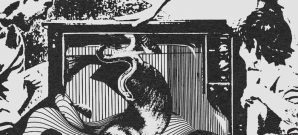 These days, the word nostalgia seems to run wild whenever a newish indie bands crank out new material. Is this an inevitability – human race’s penchant for expressing their sincerest form of flattery perpetually?
These days, the word nostalgia seems to run wild whenever a newish indie bands crank out new material. Is this an inevitability – human race’s penchant for expressing their sincerest form of flattery perpetually?
Death In The Afternoon takes every advantage to recreate the time when synths and hairspray copulated to ad nauseum. Well, they’re not so much into the aerosol can of sticky solution as much as the electronic musical instrument – all four members play one! Yet you couldn’t get away with filing Kino in the eighties new wave section. While the ghost of monophonic synth of Human League looms largely on the Swedish quartet’s second LP, Kino is a product of the twenty first century. Even the most quintessential eighties electronica – i.e. New Order’s “Blue Monday” – feels significantly analog compared to the slick wave of notes on this eleven-track album. This isn’t to insinuate DITA of producing detached music, but rather of encapsulating the intangible “future” that the likes of Gary Numan (QRO live review) perhaps tried but somehow it didn’t quite happen to the maximum due to technical setbacks of the day.
Kino’s subdued quality could easily lead itself in the bottom of a bin, if one did not have the patience to let its subtlety unfold with each spin. The pioneers of electronic music made every sound count and faced their audience head on. Whereas, DITA envelopes in a somber hesitation – they want to be noticed but not under the bright neon lights. Christian Nanzell’s vocals don’t call attention to itself; sung mostly in falsetto, it melds into the pipes of the machines, unlike his progenitors who sang with more of an alpha male complex. Every now and then, we find Nanzell singing in his natural timbre (“John Who” and “Natalya”), giving more of an identity to the most organic instrument on Kino. Though on the more single-worthy “Fandango”, Nanzell’s falsetto finds its rightful place among the flashing keys and hand clappings. Relying less or easing up on the higher vocal range, like on the album’s highlight, “Lions”, could breathe more life on an album that feels preoccupied with style rather than sentiments.
Obviously the name of the album clues in the listener of Kino’s inspiration: films. It wouldn’t be all incorrect to say that Kino comes across as a soundtrack for an existential sci-fi motion picture, conjuring imageries from a cornucopia of movies from Alphaville to Blade Runner. If we were to follow the progression of the record as a story, it feels a bit long. The seventh and the longest track, “Tricks” functions like a climax with its crescendo of gloomy industrial synths, especially after the austere “J(L)G”. But it turns out that the brief keyboard instrumental with vinyl scratch sound effect is more of an interlude. “Natalya” follows “Tricks” like a second chapter, when the protagonist has woken to contemplate, after overcoming an obstacle. Then we are treated to a pair of noteworthy numbers (“Villains” and “Lions”) before ending with the moody, drawn out “Spain”.
An improvement from DITA’s more monochromatic debut, Great White Whale, Kino gives enough reasons to believe the Swedes will further advance their love affair with synths and perhaps introduce us to the future within – in the future.


















